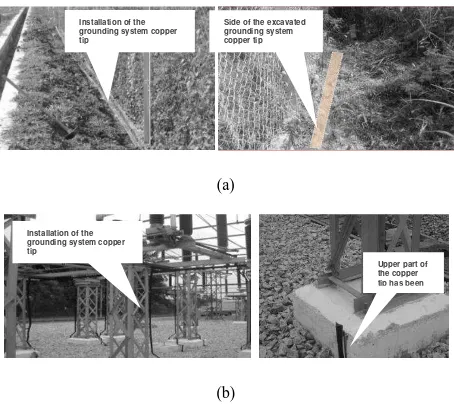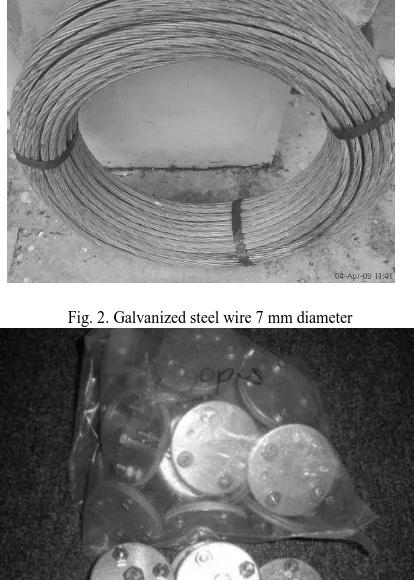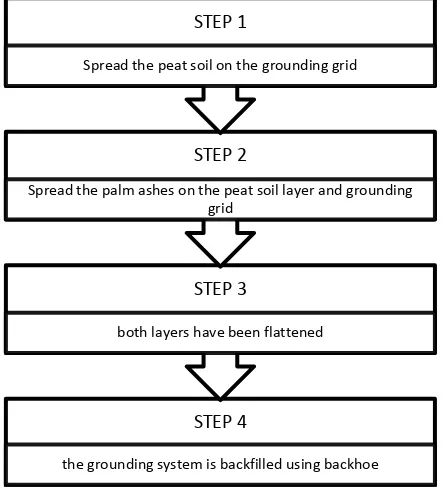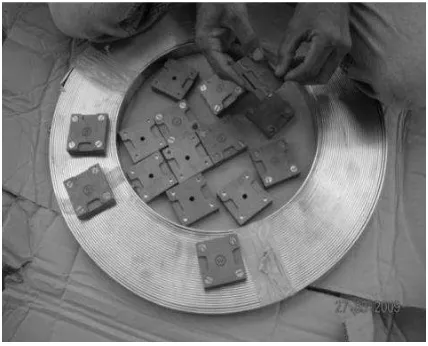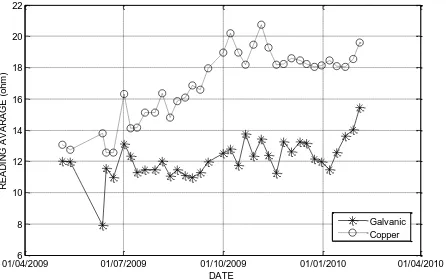Manuscript received May 2010, revised June 2010 Copyright © 2007 Praise Worthy Prize S.r.l. - All rights reserved
Anti-theft Grounding System for Industrial Application
H. Ahmad, M.A.B. Sidik, K.Y. Lau
Abstract
– Grounding systems for industrial applications are prone to theft. This is true fortelecommunication receiving, transverse and repeater towers. They are erected along highways, urban areas and residential areas to provide more coverage to users and customers. Material which is popularly used for grounding system is copper. Copper conductor has been widely used in grounding system due to its high conductivity and good resistance to underground corrosion. However, copper is a very expensive material and its recycled value is also attractive. This resulted in high cost of grounding system. For the pasts few years telecommunication utilities’ grounding system copper material are subjected to theft when installed as grounding conductor. In order to prevent the grounding system from being stolen and to reduce the cost of grounding system, this study proposed the use of galvanized steel conductor to replace copper conductor in grounding system. Galvanized steel conductor does not suffer from theft issue faced by copper conductor. Since the conductivity of galvanized steel is not as good as copper, backfills consisting of peat soil and oil palm ash are added as parts of the grounding system to improve the overall conductivity of the proposed grounding system resistance value. However to cater for high current transfer capability of the galvanized steel diameter can be increased. The anti-theft grounding system which basically use galvanized steel with soil enhancement by means of using peat soil and oil palm ashes was proven to be capable of providing reasonably low resistance value of grounding system (better than copper grounding) for monitored period of 10 months while reducing the cost of the system and preventing theft. Copyright © 2010 Praise Worthy Prize S.r.l. - All rights reserved.
Keywords:Grounding system, anti-theft grounding, galvanized steel grounding, palm ashes
I.
Introduction
Copper conductor has been widely used in grounding system. It has high conductivity and possesses the advantage of being resistance to underground corrosion since it is cathodic with respect to other metals. Therefore, the use of copper or copper-clad steel assures the integrity of underground network over years. For this reason, countries around the globe, especially China [1] are shifting towards the use of copper grounding system to replace conventional galvanized steel grounding system.
Unfortunately, copper is a very expensive material which resulted in high cost of grounding system. Apart from that, countries like Malaysia faces a serious problem of copper conductor being stolen when installed as grounding system. According to Tenaga Nasional Berhad [2], copper conductor is likely to be stolen due to its high re-trading price in Malaysia, lack of human supervision and surveillance at the substations. Fig. 1 shows grounding system copper conductors that have been stolen from electrical power and telecommunication installation.
If this issue is not taken into careful consideration, dangerous situations might arise especially when the copper conductor intended for proper grounding during
power system faults is not in service as a result of being stolen. For this reason, the installation of copper grounding system might not be a good solution for the improvement of grounding system in an environment where theft is rampant practice. Thus, alternatives have to be considered to improve the performance of grounding system while preventing it from being stolen.
(a)
(b)
Fig. 1. Installation of grounding system copper tapes (a) fencing ground and (b) equipment grounding tapes
Side of the excavated grounding system copper tip Installation of the
grounding system copper tip
Upper part of the copper tip has been Installation of the
There have been many researches proposed to improve the performance of grounding system with alternative materials in order to enhance the performance and reduce the cost of the grounding system. In 1980, Jones [3] performed a study on bentonite rods as grounding rods backfilled with bentonite. Bentonite, a type of clay consisting mineral montmorillonite (hydrous aluminium silicate) is an excellent conductive backfill. It is non-corrosive, stable and will not change its characteristics in long time. By using bentonite backfill surrounding the bentonite rod, it increased the surface area contact with the remote ground. This assured the quality of rod/soil interface while significantly lowered the rod resistance to remote ground. In the study, the use of bentonite successfully reduced the grounding resistance. It was also discovered that the number of rod installed could be reduced and thus minimizing the installation cost.
Yamane et al. [4] introduced water absorbent polymer to study the long term stability of ground resistance and compressive strength under both wet and dry condition. In their research, the anhydrous-maleic-acid polymer was used as ground resistance reducing material due to its stability under long term temperature fluctuations. In order to allow the polymer to absorb water, it was solidified by using epoxy, a type of plastic hardener. Although the amount used was only 1/160 of bentonite, it was found to be very effective. Under both dry and wet conditions, water absorbent polymer gave better results compared to electrodes that use bentonite as backfill.
Grounding system consisted of bentonite powder and waste drilling mud was proposed by Kostic et al. [5] to replace the normally used bentonite suspension. This is because grounding system using bentonite powder is significantly cheaper in terms of preparation, transportation and placement. They successfully demonstrated that ground resistance became significantly decreased especially in drought season. Multiple reductions in maximum step voltages were also recorded. In 1999, Qinbo Meng et al. [6] introduced a new method to decrease the grounding system resistance for substations located in rocky areas. This method was later being referred as “explosive grounding technique” [7] which involved three important steps: i) drilling deep holes into the ground, ii) developing cracks in the soil by means of explosions in the holes, and iii) filling the holes with low resistivity materials (LRM) under pressure. With this, a low resistivity tree-like complex network could be formed. However, practical implementation of this method is very limited because a thorough feasibility study had to be carried out considering geographical circumstances.
Another method to reduce the grounding system resistance is by creating a deep ground well near a substation [8]. By inserting a metal tube with water percolation apertures into the well, wet surrounding soil could be obtained. This condition has significant effects
towards the reduction of grounding system resistance. Unfortunately, this approach is greatly affected by the availability of ground water.
In order to decrease grounding resistance in a limited area, Li-Hsiung et al. [9] proposed the use of granulated blast furnace slag as ground resistance reduction agent. Observations showed that the reduction agent could effectively reduce the grounding resistance to 1 – 2 m. However, this method is only favoured in regions close to steel industries since granulated blast furnace slag is a by-product of steel-making process.
Martinez et al. [10] performed analysis on test scale ground electrodes buried with soil treated with resistive reduction additive (RRA). RRA composed of raw materials and residue inorganic salts obtained from mining activities from Chile. They concluded that the use of RRA allowed the reduction of grounding resistance and extension of electrical ground electrodes lifetime.
From the literature review, most of the previous researches concentrated on the use of different earth backfills to improve the performance of grounding system. For Malaysia, the condition would be very different as copper grounding system suffers from theft, which is not commonly experienced by other countries. Therefore, the addition of earth backfills into the grounding system is not sufficient since it only improves the performance of grounding system without preventing the copper conductor being stolen.
II.1. Anti-theft Grounding System
This part described on how the Anti-theft Grounding System (AGS) was being set-up. The whole grounding system generally consists of three main important materials – galvanized steel conductor, peat soil and palm ashes.
Galvanized Steel Conductor
The galvanized steel conductor used is as shown in Fig. 2. Steel clip shown in Fig. 3 was used as jointers to connect between two separated conductors. Meanwhile, high gross spray as shown in Fig. 4 was used to prevent corrosion phenomenon on galvanized steels.
Fig. 2. Galvanized steel wire 7 mm diameter
Fig. 3. Steel clip to bond steel wires togethers
Fig. 4. High gross spray for steel wires protection against corrosion
The prototype for the installation of galvanized steel conductor is as illustrated in Fig. 5. An area (15 ft × 15 ft) with the depth of 2 m was used for prototype validation purpose. In this prototype, the galvanized steel was installed based on grid configuration containing horizontal and vertical axes. Each of the axes has a length of 15 ft and the system was divided into 9 grid regions. The width of each grid is 5 ft. As noticed from Fig. 5, steel clips were used to join the separated galvanized steel conductors. Fig. 6 shows the completed installation of the galvanized steel grounding system.
Fig. 6. Completed installation of the galvanized steel grounding system without ground enhancement material
Peat Soil and Palm Ashes Backfills
Peat soil and palm ashes were added into the pit containing the galvanized steel grounding system in order to increase the effectiveness and reliability of the grounding system in term of low grounding resistance value. Palm ashes are categorized as waste materials that can be easily obtained from palm oil refineries. The mixing process involved for both of the materials is as illustrated in Fig. 7. The peat soil was spread over the grounding grid until all the grounding system was covered by it. Then, palm ashes were spread on top of the peat soil. Both of the layers have to be flattened. Lastly, the grounding system pit was refilled using the backhoe.
Fig. 7. The mixing process for peat soil and palm ash.
Fig. 8 illustrates the peat soil, palm ashes and galvanized
steel conductor profile, while Fig. 9 illustrates the completed picture of the mixing process.
Fig. 8. Profile of peat soil, palm ashes, and galvanized steel conductor on the grounding grid system
Fig. 9. The view of grounding system with backfilled consisted of palm ashes (top layer) and peat soil (bottom layer)
II.2. Copper Conductor Grounding System Copper conductor for grounding system was installed to serve as reference comparison purposes. The virgin copper conductor used is shown in Fig. 10. Fig. 11 shows the copper clips used to connect the joints between two copper conductors either as a T-junction formation or a cross formation. The grounding chamber, on the other hand, is used to cover up the grounding grid conductor and as a point of measurement to determine grounding resistance value. Plastic grounding chamber used in this project is as shown in Fig. 12.
0.5 m height
15 feet
15 feet
STEP 4
the grounding system is backfilled using backhoe
STEP 3
both layers have been flattened
STEP 2
Spread the palm ashes on the peat soil layer and grounding grid
STEP 1
Spread the peat soil on the grounding grid
1
5
mm
1
5
mm
Palm ashes
Peat soil
1
.5
m
Fig. 10. Copper conductor and coupler
Fig. 11. Galvanized coupler for grounding system galvanized steel wire
Fig. 12. Plastic grounding chamber.
Fig. 13 shows the schematic diagram of the copper grounding grid system. For this prototype, copper conductor is a grid of horizontally formation buried. Copper clips were used to join between two conductors. The lengths of the horizontal and vertical axes of the grounding grid system were 15 ft and 15 ft respectively. The width of each grid was 5 ft. The grounding system was buried 2 m into the earth. Fig. 14 shows the
completed installation of the copper grounding system with earth refilling.
Fig. 13. Prototype ground grid earthing system using copper
Fig. 14. Completed installation of the copper grounding grid system
II.3. Data Collections
After finishing the installation of two types of grounding grids, observations were carried out in order to collect data of grounding resistances. The grounding resistance values were measured by using instrument that work base on Fall of Potential Method. The data collections were carried out from May 2009 until February 2010, totally in 38 days. The collected data have agreed with the characteristics of annum climate in Malaysia.
III.
Results and Discussions
The measurement results are shown in Fig. 15. From the Fig. 14, it verified that the AGS has the capability to provide low resistance value of grounding grid system compared to the copper grounding grid system in relation to remote earth.
copper based grounding system.
However when the scope of application is extended to AC substation grounding system, then copper-based is the best. The next in term of conductive performance that can be used to discourage theft is by utilizing aluminium-based system. In term of current density capability copper is the best, follow by aluminium and last is steel.
If galvanized steel-based system is opted for AC substation grounding system, then the conductor utilization is exorbitant, the cross sectional area has to be enlarged. Ultimately its installation will be more complex and expensive due to cost of bondings and peat soil plus palm ashes that can retain water, the grain size is small, the presence of mineral and ions, using it as ground enhancement material is effective and economical. Mixing peat soil with palm ashes will improve the total soil resistivity to much lower value, thus the ground resistance value will correspondingly improve. So the problem of grounding conductors being stolen especially in the compound of telecommunication towers grounding system can now be overcome by using the proposed grounding system arrangement using peat soils plus palm ashes as ground enhancement material.
Fig. 15. Comparison of grounding performance between AGS and copper grounding system.
IV.
Conclusion
The AGS method was successfully developed. Besides that, the ground resistance value of the AGS was proven to be lower than the copper grounding system. This shows that apart from preventing the grounding system from being stolen, the AGS method is capable of providing reasonably low ground resistance value and reducing the cost of the grounding grid conductor. These
combined advantages have been demonstrated the promising application of the AGS method to replace currently utilized copper in grounding grid system by using galvanized steel cables, peat soil plus palm ashs. However AGS method is limited to telecommunication and other industrial application where the short-circuit current is low and that the current is bearable by the galvanized steel cables.
References
[1] Yexu Li, Jinxi Ma, and Farid Paul Dawalibi, “Power grounding
safety: Copper grounding system vs steel grounding system”, in
International Conference on Power System Technology, 2006. [2] Tenaga Nasional Berhad. Available: www.tnb.com.my.
[3] W.R. Jones, Bentonite rods assure ground rod installation in problem soils, IEEE Transaction on Power Apparatus and Systems, Vol. PAS-99, No. 4, 1980.
[4] H. Yamate, T. Ideguchi, M. Tokuda, and H. Koga, “Long-term stability of reducing ground resistance with water absorbent polymers”, Nippon Telegraph and Telephone Corporation, Tokyo, Japan, 1990.
[5] M.B. Kostic, Z.R. Radakovic, N.S. Radovanovic, and M.R. Tomasevic-Canovic, Improvements of electrical properties of grounding loops by using bentonite and waste drilling mud, in IEEE Proc. Gener. Trans. Dist., Volume 146, Belgrade, Yugoslavia, 1999.
[6] M. Qingbo, H Jinliang, and F.P. Dawalibi, J. Ma, A new method to decrease ground resistances of substation grounding systems in high resistivity regions, IEEE Transaction on Power Delivery, Vol. 14, No. 3, July 1999.
[7] R. Zeng, J. He, J. Zou, and X. Sheng, Novel Method in decreasing grounding resistance of urban substaions by utilizing peripheral geographical conditions, Industry Applications Conference, 37th IAS Annual Meeting, 2002.
[8] H. Jinliang, Y Gang, Y Jingping, Z Rong, B Zhang, Z Jun, and G Zhicheng, Decreasing Grounding Resistance of Substation by Deep-Ground-Well Method, IEEE Transaction on Power Delivery, Vol. .20, No. 2, April 2005.
[9] C. Li-Hsiung, C. Jiann-Fuh, L. Tsorng-Juu, and W. Wen-I, A Study of Grounding Resistance Reduction Agent Using Granulated Blast Furnace Slag, IEEE Transactions On Power Delivery, Vol. 19, No. 3, July 2004.
[10] H.E. Martinez, E.L. Fuentealba, L.A. Cisternas, H.R. Galleguillos, J.F. Kasaneva, and O.A.D.L. Fuente, A new artificial treatment for the reduction of resistance in ground electrode, IEEE Transactions on Power Delivery, Vol. 19, No. 2, April 2004.
[11] S. Petar and V. Slavko, Grounding Grid Analysis: Historical Background and Classification of Methods, International Review on Electrical Engineering, Vol. 4. No. 4, pp. 670-683, August 2009.
.
Authors’ information
Institute of High Voltage and High Current (IVAT) Faculty of Electrical Engineering
Universiti Teknologi Malaysia
81310 Skudai Johor Darul Takzim Malaysia E-mail: [email protected]
Hussein Ahmad was born in Mersing, Johor,
Malaysia on July 1, 1953. He obtained B.Sc.(Hons) and M.Sc. in Electrical Engineering from University of Strathclyde, Scotland and subsequently obtained his Ph.D. degree in High Voltage Engineering from University of Manchester Institute of Science and Technology (UMIST) in 1986. Currently he is a professor (1997
onwards) and director (2001 onwards) of Institute of High Voltage and High Current (IVAT) in Faculty of Electrical Engineering, Universiti Teknologi Malaysia, UTM Skudai, Johor Darul Takzim, Malaysia.
Muhammad Abu Bakar Sidik was born in
Palembang, South Sumatera, Indonesia. He received B.Eng (1996) in Electrical Engineering from Sriwijaya University in 1996 and then worked in one of biggest private company in Indonesia. After resign from his former employer he jointed with Sriwijaya Univeristi in 1999. He Obtained his M.Eng (2003) and Ph.D (2008) in High Voltage Engineering from Universiti Teknologi Malaysia (UTM). He is listed as lecturer at Sriwijaya University and researcher/lecturer in Institute of High Voltage and High Current (IVAT) in Faculty of Electrical Engineering, Universiti Teknologi Malaysia, UTM Skudai, Johor Darul Takzim, Malaysia.
K.Y. Lau was born in 1984 in Sarawak, Malaysia.
